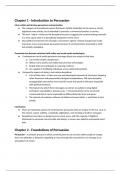Samenvatting
Summary Volledige tentamenstof Marketing and Persuasive Communication
- Instelling
- Vrije Universiteit Amsterdam (VU)
Volledige samenvatting van het boek: "The Dynamics of Persuasion" - seventh edition (2024) - Richard M. Perloff. Ook een samenvatting van "Kardes", wat ook tentamenstof is voor dit vak. Hiervan zijn hoofdstuk 2, 3 en 12 samengevat. Volledige Engelse samenvatting, Nederlandse woordenlijst onderaa...
[Meer zien]





